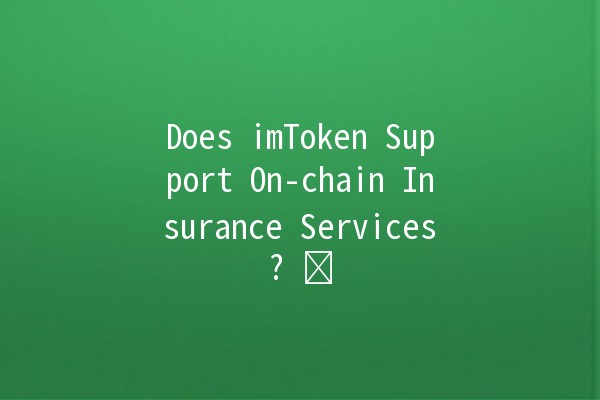In the fastevolving world of blockchain technology, users are constantly searching for robust solutions that can offer security and assurance against various risks. One of the key players in the crypto wallet sphere, imToken, has drawn considerable attention for its features. This article delves into the question of whether imToken supports onchain insurance services, exploring what this entails, how it works, and the implications for users looking to safeguard their digital assets.
Onchain insurance is a novel concept in the blockchain ecosystem aimed at protecting users against losses that may arise from smart contract failures, hacks, or unforeseen circumstances. Unlike traditional insurance, which is centralized and often complicated, onchain insurance leverages smart contracts to automate and streamline the claims process.
Onchain insurance operates by utilizing decentralized protocols that ensure transparency, efficiency, and trustworthiness. Here’s how it usually works:

As of now, imToken does not directly offer onchain insurance services integrated into its wallet platform. However, users can still utilize thirdparty insurance providers that cater to cryptocurrency and blockchain services. While imToken provides a secure environment for storing and managing digital assets, users seeking onchain insurance must look to other platforms that specialize in insurance solutions.
Nexus Mutual is a decentralized insurance platform that allows users to purchase coverage for smart contract failures on Ethereum. Users can buy insurance through their native token, NXM, which is utilized as both a premium and a governance token.
This insurance covers risks related to decentralized finance (DeFi) protocols, making it a popular choice among imToken users engaged in DeFi activities.
Etherisc aims to create a decentralized insurance protocol that permits users to develop their insurance products. This unique approach allows users to select the type of coverage according to their specific needs, from flight delays to crop insurance.
Users can participate in the governance of insurance policies via their DIP tokens, promoting community involvement in decisionmaking.
Cover Protocol offers an easy way to insure smart contracts in DeFi applications against failures. It operates on an overcollateralized model, allowing for greater transparency and less possibility of default.
Even though imToken does not provide integrated onchain insurance, the concept remains crucial for users who want to mitigate risks associated with their digital assets. Crypto markets can be volatile, and smart contract vulnerabilities can lead to significant losses. Here are five productivityenhancing tips for users to consider while dealing with onchain insurance:
Knowledge is power. Users should familiarize themselves with various insurance products available on different platforms. Understanding coverage can help make informed decisions regarding which policies suit individual needs best.
Users could follow online forums, podcasts, or websites that focus on DeFi and crypto insurance to remain updated on options and changes in offerings.
Not all insurance providers offer the same terms, coverage, or premiums. Users should obtain quotes from several providers to obtain the best coverage for their assets.
Utilizing resources like DeFi insurance comparison platforms can help users assess which provider meets their needs based on cost and coverage.
Choosing platforms that allow user governance can provide additional insight into risk assessments and policy adjustments. By being engaged, users can see how their insurance is managed and leverage their influence to improve or maintain coverage quality.
Participate in governance discussions on platforms like Nexus Mutual, ensuring that user interests are represented and changes favor sustainable growth.
As users engage with various DeFi platforms or expand their asset holdings, their insurance needs may change. Regularly reviewing coverage can prevent gaps in protection.
Establish a routine quarterly review of all coverages to ensure they align with current holdings and risk tolerance.
Using analytics tools can help users monitor their portfolio performance, identify vulnerabilities, and assess risk exposure effectively.
Tools like DeBank or Zapper offer users insights into their DeFi profiles and can highlight areas where additional insurance may be warranted based on exposure and asset performance.
imToken serves as a cryptocurrency wallet that allows users to manage and trade various cryptos, access decentralized applications (dApps), and interact with DeFi protocols. While it does not offer insurance, it is a crucial gateway for users engaging with platforms that do.
Yes, users can utilize thirdparty onchain insurance solutions like Nexus Mutual or Cover Protocol independently of their imToken wallet. Users would need to purchase insurance separately and maintain documentation for proof of coverage.
If the smart contract fails and you have coverage from an onchain insurance provider, you can file a claim according to the terms of the insurance. The smart contract governing the insurance policy will automatically prompt a payout if eligibility conditions are met.
Yes, there are inherent risks with any thirdparty service, including potential bugs in the code, governance issues, or financial instability. Always conduct thorough research about any insurance provider before purchasing a policy.
Assess the insurance provider's reputation within the blockchain community, check their smart contract audits, and review user testimonials and past payout records to gauge reliability.
Users can explore various decentralized finance forums, social media groups, or DeFi platforms specifically focusing on insurance to find and purchase coverage.
By understanding the landscape of onchain insurance and how it interacts with platforms like imToken, users can make informed choices to protect their digital assets effectively. The advent of this innovative insurance model not only provides an extra safety net but also promotes greater confidence in participating in the burgeoning world of decentralized finance.